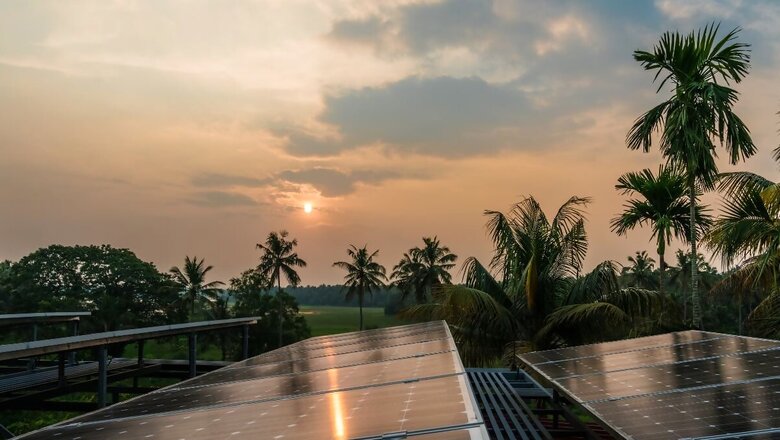
views
India’s solar energy installed capacity has risen to 85.4 GW, fuelling its clean energy ambition, according to the latest data from the Ministry of New and Renewable Energy. This has gone up from a total installed solar capacity of nearly 73.3 GW by the end of 2023.
Rajasthan continues to dominate with about 22.4 GW of installed solar capacity, followed by Gujarat at 14.3 GW, and Karnataka, Tamil Nadu at 8.8 GW and 8.6 GW, respectively. According to experts, the recent surge is likely driven by the commissioning of capacities at the giant Khavda Solar Park in Kachchh district of Gujarat. The clarity on the applicability of the Approved List of Models and Manufacturers (ALMM) policy may also have facilitated new solar capacity additions.
“The technology innovation and innovative market mechanisms have been instrumental in bringing the overall costs down. Solar is now the cheapest form of energy. But it is also variable in nature, so India needs deployment of flexible generation sources for better integration of renewable energy,” said Vibhuti Garg, Director South Asia, Institute for Energy Economics and Financial Analysis (IEEFA).
Of the total installed capacity of 85.4 GW, the ground-mounted solar plants occupy the largest share of 66.5 GW, followed by grid-connected solar rooftop which still lags behind at 12.9 GW by the end of June. The hybrid projects comprise about 2.6 GW, while the off-grid solar stands at about 3.4 GW.
ROOFTOP SOLAR: SLOW AS A SNAIL’S PACE
However, the challenge still lies with scaling up the rooftop solar capacity which has just managed to reach 12.9 GW. The solar rooftop capacity has increased but the progress has been slow. According to experts, India needs to introduce innovative financial mechanisms as high upfront capital cost is one the big bottleneck.
After the launch of Phase-2 of the Rooftop Solar Programme in 2019 to achieve 40 GW of rooftop solar, the government launched a nation-wide central scheme worth Rs 75,021 crores early this year to provide free electricity to one crore households who opt to install rooftop solar electricity. The scheme promises 300 units of free electricity every month to each household — a subsidy of 60 per cent of the solar unit cost for systems up to 2 kW and 40 per cent of the additional system cost for systems 2 to 3 kW capacity. At current benchmark prices, this comes to Rs 30,000 subsidy for 1 kW system, Rs 60,000 for 2 kW systems and Rs 78,000 for 3 kW systems or higher.
REACHING 500 GW BY 2030, 280 GW FROM SOLAR
As of June, 2024, India’s total renewable energy installed capacity (excluding large hydro) stands at around 148 GW, out of which 85.4 GW is solar, while wind occupies about 46.6 GW, biomass is 9.4 GW and small hydro is 5 GW.
“In 2023, India added 10.02 GW of solar capacity, and in the first half of 2024 alone, it achieved 12.16 GW of installations. The current solar power capacity positions India in a close race for the third spot alongside Japan, following China (~430 GW) and the United States (~142 GW),” said Charith Konda, Energy Specialist, IEEFA.
Solar energy is expected to provide at least 280 GW out of the total 500 GW of non-fossil fuel capacity that India has committed to install by 2030 as part of its climate action. Last April, the MNRE had also announced that it will invite bids for 50 GW of renewable energy capacity annually for the next five years till FY2027-28 to meet the goal. However, it is still short of the meeting its yearly targets of non-fossil fuel capacity addition needed to reach the 2030 goal. It has so far achieved about 14 GW of non-fossil fuel capacity addition during the first half of 2024.
“There are some challenges in expediting project commissioning which need to be dealt with – mainly the delays in land acquisition, difficulties in getting approvals (especially for open access projects), as well as the delays in signing power purchase agreements (PPAs), and obstacles in achieving timely financial closures,” added Konda.


















Comments
0 comment